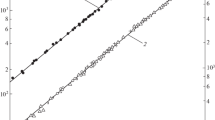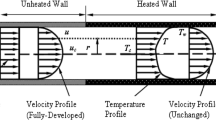Abstract
A numerical study of fluid flow and heat transfer in a two-dimensional channel under fully developed turbulent conditions is reported. A computer program which is capable of treating both forced and natural convection problems under turbulent conditions has been developed. The code uses the high-Reynolds-number form of the two equation turbulent model(k-ɛ) in which a turbulent kinetic energy near-wall model is incorporated in order to accurately represent the behavior of the flow near the wall, particularly in the viscous sublayer where the turbulent Reynolds number is small. A near-wall temperature model has been developed and incorporated into the energy equation to allow accurate prediction of the temperature distribution near the wall and, therefore, accurate calculation of heat transfer coefficients.
The sensitivity of the prediction of flow and heat transfer to variations in the coefficients used in the turbulence model is investigated. The predictions of the model are compared to available experimental and theoretical results; good agreement is obtained. The inclusion of the near-wall temperature model has further improved the predictions of the temperature profile and heat transfer coefficient. The results indicate that the turbulent kinetic energy Prandtl number should be a function of Reynolds number.
Zusammenfassung
Es wird über eine numerische Studie der Strömung und des Wärmetransportes in einem zweidimensionalen Kanal mit voll entwickelter Turbulenz berichtet. Ein Computer-programm wurde entwickelt, das in der Lage ist, sowohl Zwangsais auch Naturkonvektion unter turbulenten Bedingungen zu behandeln. Das Programm verwendet die „High-Reynolds-Number“-Form des turbulenten Zweigleichungsmodells(k-ɛ-Modell in das ein Ansatz für die wandnahe, turbulente, kinetische Energie eingearbeitet ist, um das Verhalten der Strömung nahe der Wand genau wiederzugeben, insbesondere in der viskosen Unterschicht, wo die turbulente Reynolds-Zahl klein ist. Es wurde ein wandnahes Temperaturmodell entwickelt und in die Energiegleichung eingearbeitet, um eine genaue Vorhersage der Temperaturverteilung nahe der Wand zu ermöglichen und damit die Wärmeübergangskoeffizienten genau zu berechnen.
Die Empfindlichkeit für die Vorhersage der Strömung und der Wärmeübertragung auf Veränderungen in den Koeffizienten des verwendeten Turbulenzmodells wird untersucht. Die Vorhersagen des Modells werden mit verfügbaren experimentellen Daten und theoretischen Ergebnissen verglichen. Es wurde gute Übereinstimmung erzielt. Die Einbeziehung des wandnahen Temperaturmodells brachte weitere Verbesserung der Vorhersage des Temperaturprofils und des Wärmeübergangskoeffizienten. Die Ergebnisse zeigen, daß die turbulente, kinetische Prandtl-Zahl eine Funktion der Reynolds-Zahl sein sollte.
Similar content being viewed by others
Abbreviations
- A :
-
empirical coefficient, Eq. (27)
- b :
-
channel width
- cl :
-
constant of proportionality between length scalel and distance from wall (applied over near-wall cell)=2.55, Eq. (17)
- C 1, C2,C μ∞ :
-
constants in thek-ɛ turbulent model, Eq. (8)
- c p :
-
specific heat
- E * :
-
constant in logarithmic velocity profile=5.0, Eq. (12)
- k :
-
turbulent kinetic energy
- K :
-
empirical coefficient, Eq. (27)
- l m :
-
mixing length
- Nu :
-
Nusselt number, Eq. (19)
- p :
-
pressure
- Pr :
-
Prandtl number=ν/α
- Re :
-
Reynolds number=υmb/2ν
- Re t :
-
turbulent Reynolds number, Eq. (10)
- Re Γ :
-
viscous sublayer Reynolds number=y v k 1/2 v /v=20.0
- ¯Re :
-
average Reynolds number
- t :
-
time
- T :
-
temperature
- u :
-
velocity inx-direction
- ν :
-
velocity iny-direction
- x :
-
horizontal coordinate; main flow direction
- y :
-
vertical coordinate
- α :
-
thermal diffusivity
- ɛ :
-
dissipation rate of turbulence energy
- χ :
-
von Karman constant=0.4187
- χ * :
-
constant in logarithmic velocity profile=χ C 1/4μ∞ =0.23
- λ :
-
thermal conductivity
- μ :
-
laminar dynamic fluid viscosity
- μ t :
-
turbulent dynamic fluid viscosity
- ν :
-
laminar kinematic fluid viscosity
- ϱ :
-
density
- σ k :
-
turbulent kinetic energy Prandtl number
- σ t :
-
turbulent temperature Prandtl number
- σɛ :
-
turbulent dissipation Prandtl number
- τ :
-
shear stress
- b :
-
bulk
- c :
-
cold
- e :
-
edge of near-wall cell
- E :
-
center of cell adjacent to the near-wall cell
- h :
-
hot
- m :
-
maximum of experimental value
- P :
-
center of near-wall cell
- t :
-
turbulent
- υ :
-
edge of viscous sublayer
- w :
-
wall
References
Jones, W. P.; Launder, B. E.: The prediction of laminarization with a two-equation model of turbulence. Int. J. Heat Mass Transfer 15 (1972) 301–314
Jones, W. P.; Launder, B. E.: The calculation of low-Reynolds-number phenomena with a two-equation model of turbulence. Int. J. Heat Mass Transfer 16 (1973) 1119–1130
Launder, B. E.; Spalding, D. B.: The numerical computation of turbulent flows. Computer Methods in Applied Mechanics and Engineering 3 (1974) 269–289
Chieng, C. C.; Launder, B. E.: On the calculation of turbulent heat transport downstream from an abrupt pipe expansion. Numerical Heat Transfer 3 (1980) 189–207
Amano, R. S.: Development of a turbulence near-wall model and its application to separated and reattached flows. Numerical Heat Transfer 7 (1984) 59–75
Johnson, R. W.; Launder, B. E.: Discussion of: On the calculation of turbulent heat transport downstream from an abrupt pipe expansion. Numerical Heat Transfer 5 (1982) 493–496
Sindir, M. M.: Numerical study of turbulent flows in backward-facing step geometries: Comparison of four models of turbulence. Ph.D. Thesis, Mechanical Engineering Department, Univ. of Calif, Davis, 1982
Sindir, M. M.: Effects of Expansion ratio on the calculation of parallel-walled backward-facing step flows: Comparison of four models of turbulence. ASME Paper No. 83-FE-10, 1983
Sindir, M. M.: Calculation of deflected-walled backwardfacing step flows: Effects of angle of deflection on the performance of four models of turbulence. ASME Paper No. 83-FE-16, 1983
Sindir, M. M.; Harsha, P. T.: Assessment of turbulence models for scramjet flowfields. NASA Contractor Report 3643, November 1982
Humphrey, J. A. C.; Pourahmadi, F.: A generalized algebraic relation for predicting developing curved channel flow with ak-ɛ model of turbulence. 3rd symposium on turbulent shear flow. Univ. of Calif., Davis, 1983 (also Lawrence Berkeley Laboratory Report, LBL-12009)
Humphrey, J. A. C.; Chang, S. M.: Turbulent flow in passage around a 180° bend: An experimental and numerical study. Univ. of Calif. Berkeley, Rep. FM-83-7, 1983
Naot, D.; Rodi, W.: Calculation of secondary currents in channel flow. ASCE J. Hydraulics Division 108 (1982) 948–968
Rodi, W.: Turbulence models and their application in hydraulics — a state of the art review. Univ. Karlsruhe Report. SFB 80/T/127, Fed. Rep. Germany, 1978
Washington, L.; Marks, W. M.: Heat transfer and pressure drop in rectangular air passages. Ind. and Eng. Chem. 29 (1937) 337–345
Corcoran, W. H.; Roudebush, B.; Sage, B. H.: Temperature gradients in turbulent gas streams: Preliminary studies. Chem. Eng. Prog. 43 (1947) 135–142
Corcoran, W. H.; Page, F., Jr., Schlinger, W. H.; Sage, B. H.: Temperature gradients in turbulent gas streams: Methods and apparatus for flow between parallel plates. Ind. and Eng. Chem. 44 (1952) 410–419
Page, F., Jr.; Corcoran, W. H.; Schlinger, W. G.; Sage, B. H.: Temperature gradients in turbulent gas streams: Temperature and velocity distributions in uniform flow between parallel plates. Ind. Eng. Chem. 44 (1952) 419–424
Page, F., Jr.; Schlinger, W. G.; Breaux, D. K.; Sage, B. H.: Temperature gradients in turbulent gas streams: Point values of eddy conductivity and viscosity in uniform flow between parallel plates. Ind. Eng. Chem. 44 (1952) 424–430
Laufer, J.: Investigation of turbulent flow in a two-dimensional channel. NACA Technical Note 2123, 1950
Clark, J. A.: A study of incompressible turbulent boundary layers in channel flow. ASME J. Basic Eng. 90 (1968) 455–468
Hussain, A. K. M. F.; Reynolds, W. C.: Measurement of fully developed turbulent channel flow. ASME J. Fluids Eng. 97 (1975) 568–580
El Telbany, M. M. M.; Reynolds, A. J.: Velocity distributions in plane turbulent channel flows. J. Fluid Mech. 100 (1980) 1–29
El Telbany, M. M. M.; Reynolds, A. J.: Turbulence in plane channel flows. J. Fluid Mech. III (1981) 283–318
Lancet, R. T.: The effect of surface roughness on the convection heat-transfer coefficient for fully developed turbulent flow in ducts with uniform heat flux. ASME J. Heat Transfer 81 (1959) 168–174
Levy, S.; Fuller, R. A.; Niemi, R. O.: Heat transfer to water in thin rectangular channels. ASME J. Heat Transfer 81 (1959) 129–143
Sparrow, E. M.; Lloyd, J. R.; Hixon, C. W.: Experiments on turbulent heat transfer in an asymmetrically heated rectangular duct. ASME J. Heat Transfer 88 (1966) 170–174
Martinelli, R. C.: Heat transfer to molten metals. Trans. ASME 69 (1947) 947–960
Harrison, W. B.; Menke, J. R.: Heat transfer to liquid metals flowing in asymmetrically heated channels. Trans. ASME 71 (1949) 797–803
Seban, R. A.: Heat transfer to a fluid flowing turbulently between parallel walls with asymmetric wall temperatures. Trans. ASME 72 (1950) 789–795
Hatton, A. P.; Quarmby, A.: The effect of axially varying and unsymmetrical boundary conditions on heat transfer with turbulent flow between parallel plates. Int. J. Heat Mass Transfer 6 (1963) 903–914
Hatton, A. P.; Quarmby, A.; Grundy, I.: Further calculations on the heat transfer with turbulent flow between parallel plates. Int. J. Heat Mass Transfer 7 (1964) 817–823
Barrow, H.: Convection heat transfer coefficients for turbulent flow between parallel plates with unequal heat fluxes. Int. J. Heat Mass Transfer 1 (1961) 306–311
Barrow, H.: An analytical and experimental study of turbulent gas flow between two smooth parallel walls with unequal heat fluxes. Int. J. Heat Mass Transfer 5 (1962) 469–487
Barrow, H.; Lee, Y.: Heat transfer with unsymmetrical thermal boundary conditions. Int. J. Heat Mass Transfer 7 (1964) 580–582
Launder, B. E.; Sharma, B. I.: Application of the energy-dissipation model of turbulence to the calculation of flow near a spinning disc. Letters in Heat and Mass Transfer 1 (1974) 131–138
Spalding, D. B.: Heat transfer from turbulent separated flows. J. Fluid Mechanics 27 (1967) 97–109
Pope, S. B.; Whitelaw, J. H.: The circulation of near-wake flows. J. Fluid Mech. 73 (1976) 9–32
Launder, B. E.; Spalding, D. B.: Lectures in mathematical models of turbulence. New York: Academic Press 1972
Gadgil, A.: On convective heat transfer in building energy analyses. Ph.D. Thesis, Department of Physics. Univ. of Calif., Berkeley, 1979 (also Lawrence Berkeley Laboratory Report, LBL-10900)
Patankar, S. V.; Spalding, D. B.: Heat and Mass Transfer in Boundary Layers. London: Morgan-Grampion 1967
Maurer, G. W.; Le Tourneau, B. W.: Friction factors for fully developed turbulent flow in ducts with and without heat transfer. ASME J. Basic Eng. 86 (1964) 627–636
Author information
Authors and Affiliations
Rights and permissions
About this article
Cite this article
Akbari, H., Mertol, A., Gadgil, A. et al. Development of a turbulent near-wall temperature model and its application to channel flow. Wärme- und Stoffübertragung 20, 189–201 (1986). https://doi.org/10.1007/BF01303450
Received:
Issue Date:
DOI: https://doi.org/10.1007/BF01303450




